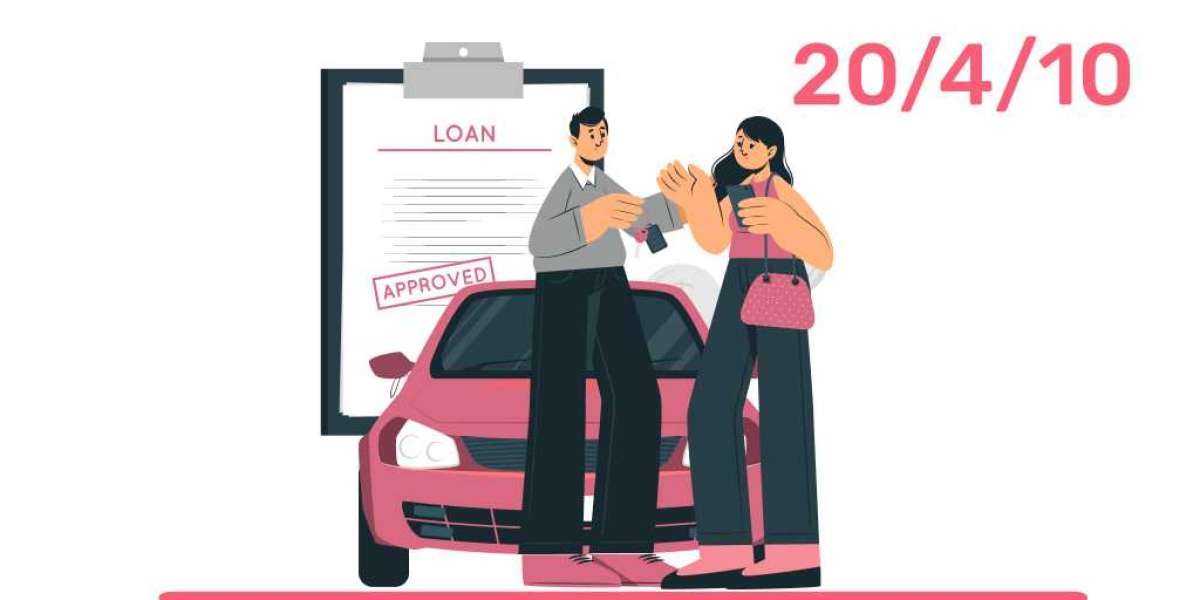Are you in the market for a new car? Buying a vehicle can be an exciting yet daunting task. With so many options and financial considerations, it's easy to feel overwhelmed. However, there's a simple rule that can help guide your decision-making process: the 20/4/10 rule for buying a car. This article will explore this rule in depth and show you how to apply it to your car-buying journey.
What is the 20/4/10 Rule?
The 20/4/10 rule is a financial guideline for purchasing a car. It breaks down into three main components:
- 20% - Put down at least 20% of the car's value as a down payment.
- 4 - Finance the vehicle for no more than 4 years.
- 10 - Ensure your total monthly vehicle expenses don't exceed 10% of your gross income.
By following this rule, you can make a more informed and financially responsible car purchase. Let's dive deeper into each component and explore how to apply them effectively.
The 20% Down Payment
Putting down a significant down payment is crucial when buying a car. Here's why the 20% rule matters:
- Reduces the loan amount: A larger down payment means you borrow less money.
- Lowers monthly payments: With less to finance, your monthly payments will be smaller.
- Decreases interest paid: You'll pay less interest over the life of the loan.
- Helps avoid being "underwater" on the loan: Cars depreciate quickly, but a 20% down payment helps maintain equity.
How to Save for a 20% Down Payment?
Saving for a substantial down payment requires planning and discipline. Here are some strategies to help:
- Set a clear savings goal: Determine the price range of cars you're considering.
- Create a dedicated savings account: Keep your car fund separate from other savings.
- Automate your savings: Set up automatic transfers to your car fund each payday.
- Cut unnecessary expenses: Identify areas where you can reduce spending to save more.
- Consider a side hustle: Look for ways to earn extra income for your down payment.
Remember, the more you save, the better position you'll be in when it's time to buy. Additionally, a larger down payment can help you negotiate better loan terms with lenders.
The 4-Year Financing Rule
Limiting your car loan to four years or less is the second component of the 20/4/10 rule. Here's why this is important:
- Lower total interest paid: Shorter loans typically have lower interest rates and less total interest.
- Faster equity buildup: You'll own a larger portion of the car sooner.
- Reduced risk of being "underwater": The loan balance is less likely to exceed the car's value.
- Alignment with car's lifespan: Your loan term better matches the vehicle's useful life.
Challenges of Longer Loan Terms
While longer loan terms might seem attractive due to lower monthly payments, they come with risks:
- Higher interest rates: Lenders often charge more for extended loan terms.
- More total interest paid: You'll pay significantly more over the life of the loan.
- Slower equity buildup: It takes longer to own a substantial portion of the car.
- Increased risk of negative equity: The car may depreciate faster than you pay down the loan.
How to Stick to a 4-Year Loan?
To adhere to the 4-year financing rule, consider these strategies:
- Choose a less expensive car: Consider a more affordable model or a used vehicle.
- Improve your credit score: Better credit can lead to lower interest rates.
- Shop around for loans: Compare offers from multiple lenders to find the best terms.
- Consider refinancing: If you already have a longer loan, look into refinancing options.
The 10% Monthly Expense Rule
The final component of the 20/4/10 rule focuses on your monthly car-related expenses. These should not exceed 10% of your gross monthly income. This includes:
- Car loan payment
- Insurance premiums
- Fuel costs
- Maintenance and repair expenses
Why the 10% Rule Matters?
Limiting your car expenses to 10% of your income helps in several ways:
- Ensures affordability: You're less likely to struggle with car payments.
- Allows for other financial goals: You'll have room in your budget for savings and investments.
- Provides a buffer for unexpected expenses: You'll be better prepared for financial emergencies.
- Reduces financial stress: You won't feel overwhelmed by your car-related costs.
Calculating Your 10% Threshold
To determine your maximum monthly car expenses, follow these steps:
- Calculate your gross monthly income: This is your income before taxes and deductions.
- Multiply that number by 0.10: This gives you 10% of your gross monthly income.
- Subtract estimated insurance, fuel, and maintenance costs from this number.
- The remaining amount is your maximum car payment.
For example, if your gross monthly income is $5,000:
10% of $5,000 = $500
Estimated monthly insurance: $100
Estimated monthly fuel cost: $150
Estimated monthly maintenance: $50
Maximum car payment: $500 - $300 = $200
Strategies to Stay Within the 10% Limit
If you're struggling to keep your car expenses under 10%, consider these options:
- Choose a more fuel-efficient vehicle: This can significantly reduce your monthly fuel costs.
- Shop around for better insurance rates: Compare quotes from multiple providers.
- Perform regular maintenance: This can help prevent costly repairs down the line.
- Consider a less expensive car: A cheaper vehicle means lower payments and often lower insurance costs.
Applying the 20/4/10 Rule in Practice
Now that we've covered each component, let's look at how to apply the rule in real-life scenarios. Here's a step-by-step guide:
- Determine your budget: Calculate 10% of your gross monthly income.
- Research car prices: Look for vehicles that fit within your budget.
- Save for the down payment: Aim for at least 20% of the car's value.
- Shop for loans: Look for 4-year (or shorter) loan terms with competitive interest rates.
- Calculate total monthly costs: Ensure all car-related expenses stay under your 10% threshold.
Benefits of Following the 20/4/10 Rule
Adhering to this rule offers numerous advantages:
- Financial stability: You're less likely to overextend yourself financially.
- Better long-term financial health: You'll have more money for other financial goals.
- Reduced stress: You won't feel burdened by excessive car payments.
- Improved negotiating position: A substantial down payment can lead to better loan terms.
- Faster equity buildup: You'll own a larger portion of your car sooner.
Challenges and Considerations
While the 20/4/10 rule is a solid guideline, it may not work for everyone. Here are some challenges and considerations:
- High-cost living areas: In expensive cities, the 10% rule may be difficult to follow.
- Lower incomes: Those with lower incomes may struggle to save a 20% down payment.
- Specific vehicle needs: Some people may require more expensive vehicles for work or family reasons.
- Market conditions: In times of high interest rates, 4-year loans may be less available.
Alternatives to the 20/4/10 Rule
If the 20/4/10 rule doesn't work for your situation, consider these alternatives:
- The 20/10 rule: Similar, but allows for longer loan terms if necessary.
- The 36% rule: Ensures all debt payments (including car) don't exceed 36% of income.
- The 50/30/20 budget: Allocates 50% for needs, 30% for wants, and 20% for savings.
Remember, these are guidelines, not strict rules. Adapt them to your specific financial situation and goals.
Tips for Successful Car Buying
Beyond the 20/4/10 rule, here are some additional tips for a successful car purchase:
- Research thoroughly: Compare different models, read reviews, and check reliability ratings.
- Get pre-approved for a loan: This gives you leverage when negotiating at the dealership.
- Negotiate the total price, not the monthly payment: Don't let salespeople focus solely on monthly costs.
- Consider certified pre-owned vehicles: These can offer reliability at a lower price point.
- Don't skip the test drive: Ensure the car meets your needs and preferences.
- Check the vehicle history: For used cars, always review the vehicle's history report.
- Be prepared to walk away: Don't feel pressured into a deal that doesn't work for you.
The Role of Emotions in Car Buying
It's important to recognize the emotional aspect of car buying. Many people make decisions based on feelings rather than facts. To counteract this:
- Stick to your budget: Don't let excitement lead you to overspend.
- Focus on needs over wants: Prioritize practical features over luxury add-ons.
- Take your time: Don't rush into a decision; sleep on it if necessary.
- Bring a level-headed friend: They can offer objective opinions and keep you grounded.
The Future of Car Buying and the 20/4/10 Rule
As the automotive industry evolves, so too might car-buying strategies. Consider these future trends:
- Electric vehicles: The 20/4/10 rule may need adjusting for higher upfront costs but lower operating expenses.
- Subscription services: Monthly car subscriptions might change how we calculate transportation costs.
- Autonomous vehicles: These could impact how we value and finance personal transportation.
Stay informed about these trends and be prepared to adapt your car-buying strategy accordingly.
Conclusion
The 20/4/10 rule provides a solid framework for making a responsible car purchase. By putting down a substantial down payment, limiting your loan term, and keeping monthly expenses in check, you can enjoy your new vehicle without financial stress. Remember, this rule is a guideline. Adapt it to your specific situation and financial goals. With careful planning and smart decision-making, you can drive off in a car that meets your needs without breaking the bank. Happy car shopping!







